The biggest entertainment stories
Get our big stories about Hollywood, film, television, music, arts, culture and more right in your inbox as soon as they publish.
You may occasionally receive promotional content from the Los Angeles Times.
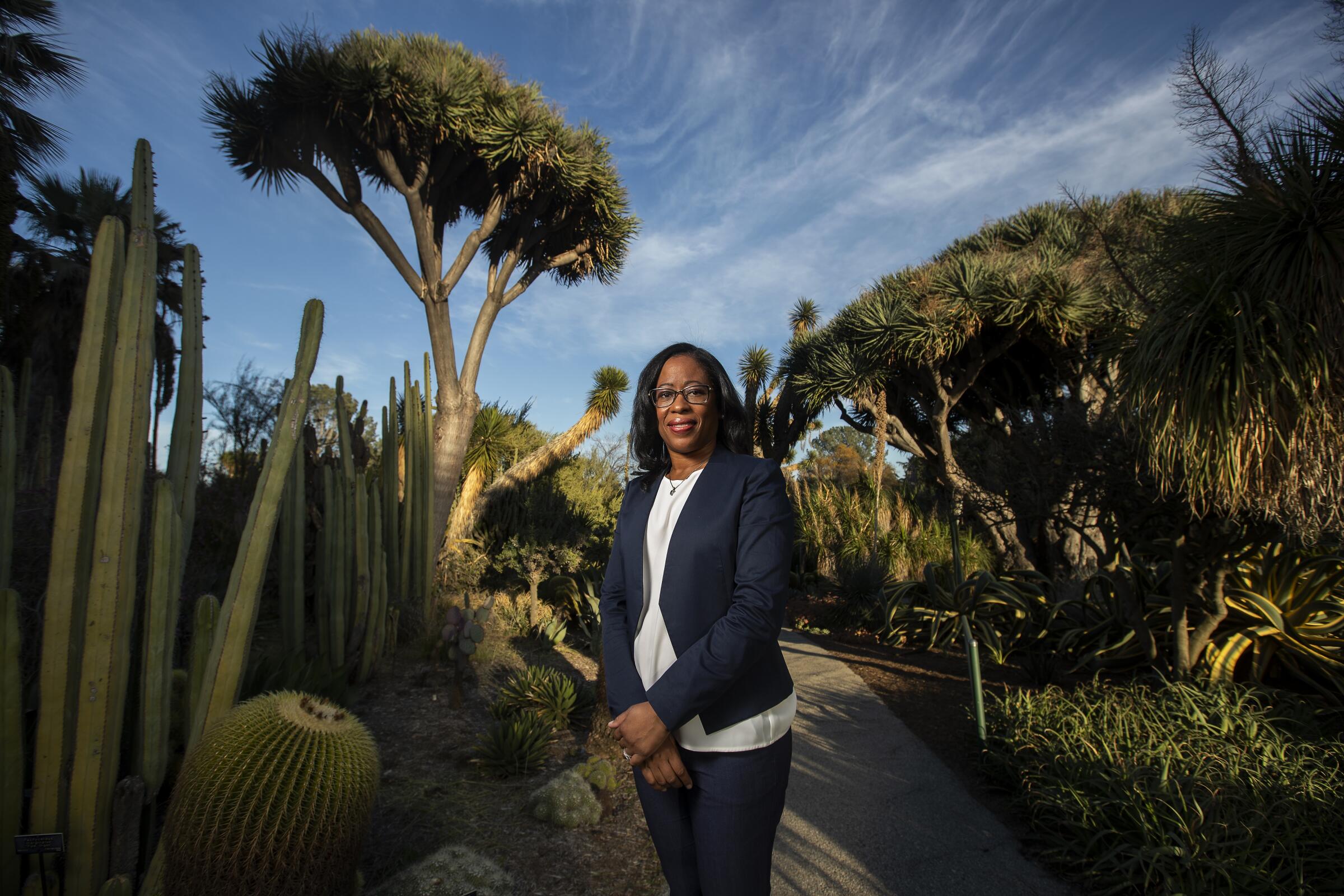
Beneath every robber baron’s graceful mansion seems to lie a graveyard of questionable deeds.
Cue Henry E. Huntington. Business mogul. Rail magnate. Rapacious real estate developer. Cantankerous enemy of organized labor.
Cue, also, Henry E. Huntington. Devoted aesthete. Prolific collector of art and books and plants, who left the lot to the public in the form of the Huntington Library, Art Museum, and Botanical Gardens on land that was once his vast San Marino estate.
Now, 102 years after he and his wife Arabella Duval Huntington founded it, this patrician institution finds itself at a crossroads — the benefactor of Gilded Age wealth attempting to evolve into the post-George Floyd era, when art museums around the country are reckoning with questions of equity and race.
The Huntington, like countless other institutions, is contending with a lack of diversity in its senior ranks, which for most of its lifespan has been all white. It is also coming to terms with its history, one that sustained cultural narratives largely built on Anglo European traditions for a museum in a part of the country that is largely Latino and mestizo. And one that, like other baronial estate museums — the Frick Collection and the Morgan Library & Museum in New York — was built around the inescapable identity of a powerful founder. Henry Huntington was a great philanthropist ... who was also pretty great at being exploitative, not to mention just plain fallible.

“How do we rethink the past? And how do we establish the future we want to see?” asks Christina Nielsen, director of the Huntington’s art museum.
Certainly, getting to a more equitable version of the future is going to take some work — and some unsentimental self-examination.
“We need to look with a detached historical eye and not do hagiography,” Nielsen says.
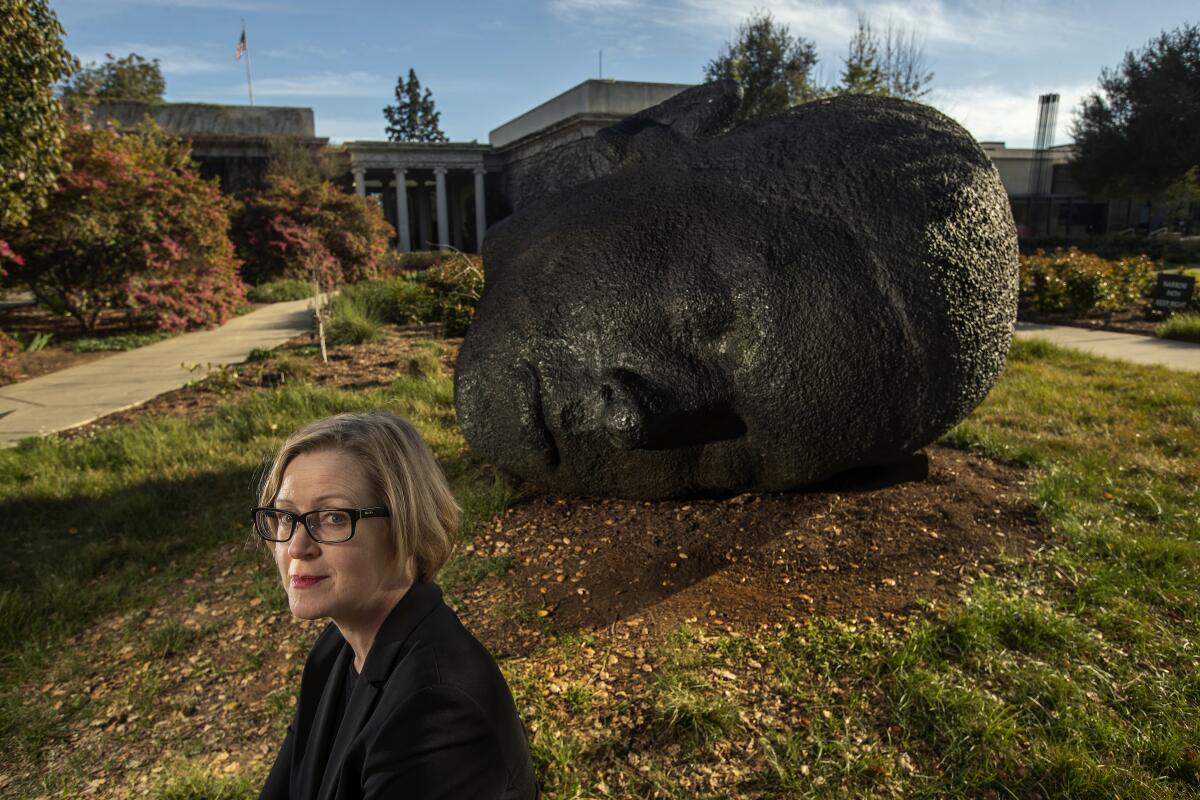
Huntington amassed fabulous wealth in part by inheriting it from his uncle, the ruthless railroad tycoon Collis P. Huntington (who, curiously, was also an abolitionist who supported Booker T. Washington), but also by building out L.A.’s trolley system while speculating the hell out of the real estate that surrounded it. To this end, Huntington saw in organized labor a mortal enemy. His companies hired detectives to trail organizers, fired employees who joined unions and deployed scabs as needed. In a 1919 interview with The Times, he suggested deporting union organizers affiliated with the Industrial Workers of the World, describing them as “un-American aliens.” When architect Myron Hunt designed Huntington’s library, he made sure to employ only nonunion contractors.
Separately, the tycoon maintained a tiered payment system for the workers who labored for him: White workers, many of whom lived on-site, were paid one wage; Mexican laborers, who lived elsewhere — often commuting from San Gabriel — received less.
The Latinx experience chronicled
Get the Latinx Files newsletter for stories that capture the multitudes within our communities.
You may occasionally receive promotional content from the Los Angeles Times.
“I remember having lunch with my dad, a Mexican immigrant with an eighth-grade education, at the Huntington,” recalls historian Natalia Molina, who is researching the Huntington’s labor history, “and him saying, ‘Our people built this.’”
What they built wasn’t simply Huntington’s estate but what would one day become a key center of scholarship in Southern California: an archive and museum blessed with Huntington’s personal trove of books and manuscripts, including a rare Gutenberg Bible, as well as an important collection of American and European art that has at its heart a cache of invaluable British Grand Manner portraits from the 18th century, including Thomas Gainsborough’s “The Blue Boy” as well as Thomas Lawrence’s “Pinkie.”
And, of course, there are the gardens, which include 120 acres of rigorously tended landscapes such as a desert garden, a rose garden, a camellia garden, a Japanese garden and the newly expanded Chinese garden.

Today, the Huntington maintains archives of medieval manuscripts, colonial documents, imperial maps, papers related to various U.S. presidents, including Abraham Lincoln, as well as pamphlets, posters, architectural drawings and even the archives of award-winning sci-fi author Octavia E. Butler, whose novels, which explored themes such as colonization, slavery and environmental degradation, increasingly seem less like fiction than documents from the future.
The fact that the Huntington is an important research center makes diversity even more critical, since as an institution it is in a position to influence history. Molina, a USC historian who was named a MacArthur fellow last year, is conducting research at the Huntington for an upcoming book, “The Silent Hands That Shaped the Huntington: A History of Its Mexican Gardeners.”
“Keeping archives is an expensive enterprise,” she says. “So there is a hierarchy in whose stories get told and whose histories are preserved and collected. ... This affects the composition of the archives and the composition of the scholars who tell the stories and affects the audience who hears the story.”
History can be self-perpetuating.
On the surface, the Huntington’s diversity numbers look pretty good.
A sprawling institution made up of three major divisions — a museum, a library and the botanical gardens — the Huntington has a total of 457 staffers, nearly half of whom identify as BIPOC (Black, Indigenous and people of color). But take out the facilities workers and the picture gets whiter. Of the 250 knowledge workers (curators, librarians, administrators), only 17% are BIPOC. And while there are BIPOC curators in the gardens and the library, the art museum counts not a single BIPOC curator among its staff.
A centennial exhibition at the Huntington Library, Art Museum and Botanical Gardens looks back at its founding year.
At the leadership levels, the lack of representation is especially glaring.
While impossible to verify, it’s almost certain, according to those with knowledge of the institution’s history, that senior management at the Huntington has been 100% white for more than a century. It was only in January that the senior management team added its first Black member: Misty Bennett, a former executive from the Rosewood Hotel Group, who came on board as chief human resources officer. And just this week, plant scientist Nicole Cavender was named the Huntington’s director of botanical gardens, the first woman to hold the job.
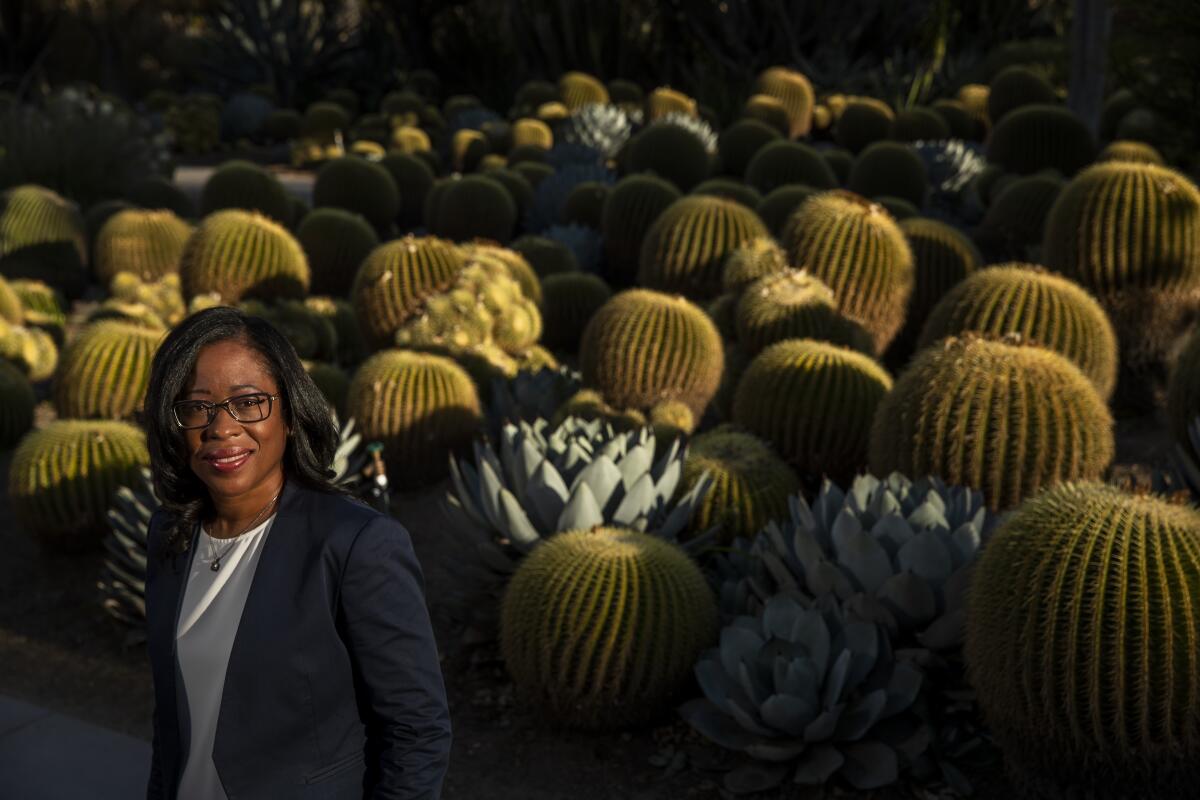
The boards tell a similar tale of skewed representation. There is the Board of Governors, which functions like an advisory group. That body has 63 members; 10 of whom are people of color. The museum is also governed by five trustees, four of whom are white and Simon K.C. Li, who is Asian. (Li was an assistant managing editor at The Times until 2007. His wife, June Li, was the founding curator of the Huntington’s Chinese garden.)
It goes without saying that these numbers do not begin to reflect the demographics of Los Angeles County, which is overwhelmingly Latino (almost 50%), with substantial Asian (15%) and Black populations (9%).
Bennett says that one of her first orders of business is to bring some intention to the process of hiring, which has been scattershot.
Positions were posted on the Huntington’s website and hiring was done almost exclusively by the hiring manager, with people reaching out to their individual networks for candidates — a process that has kept the institution insular. (The Huntington has had several high-level positions come open over the last three years in which there were opportunities to recruit people of color, yet this was not done.)
“We have to be very deliberate in the talent we attract,” Bennett says. “We have to hunt for talent. We have to be creative in looking for that talent and understand what organizations they might belong to, where I might find them. Are we looking at HBCUs? Or professional organizations targeting Latinx communities?”
Last August, as part of pandemic-related belt tightening, the Huntington laid off eight people, including the chief curator of European art (a mystifying choice given the institution’s focus on ... European art). There was a freeze on new hiring. But the freeze has been lifted and the Huntington now aims to fill two open curatorial positions in the museum and the library. “I plan to be reaching out to a range of Black curators, Hispanic curators,” Bennett says. “That’s something I’m focused on.”
This year, there will also be an opportunity to diversify the Board of Governors (which until recently was known by the unfortunate title Board of Overseers). “Terms expire every year,” says Susan Turner-Lowe, vice president for communications and marketing. “We are looking to add more members with diverse backgrounds. We have several of those positions opening up this year.”
Much more than simply increasing diversity, the task ahead will consist of rethinking the very ways in which museums are governed.
An analysis of pay is also in the works. “Benchmarking compensation to ensure equity is one of my biggest priorities,” Bennett says. “What I intend to do is look at every single position. ... We want to make sure that we are offering competitive wages based on the position.”
Examining pay equity within the Huntington’s ranks would also be a good move.
Like other institutions, the Huntington has a vast gap between the highest- and lowest-paid staffers. Salaries for the senior management team start in the low six figures and run to $400,000. In addition, Huntington President Karen Lawrence is supplied with free housing on-site, as is the botanical director. Yet museum guards earn a base rate of $14 an hour, the San Marino minimum wage — which is lower than the $15-an-hour minimum wage that would be required of a similar institution in the city of Los Angeles.
That’s right: San Marino, the fabulously wealthy residential enclave devised by the fabulously wealthy Henry Huntington, where the median household income is more than $166,000 a year, has a lower minimum wage than L.A. (median household income: $68,000).

To be certain, the Huntington’s ongoing diversification efforts predate the recent social uprisings.
In 2017, scholar Cecilia Caballero wrote an essay for a website called Chicana M(other)work that addressed some of the institution’s historic inequities and alleged some overzealous policing by the museum’s guards. Afterward, a group of Huntington employees sent a letter to management expressing concern over issues of diversity and inclusion.
Cris Lutz, the Huntington’s vice president of gift planning, who is Latina, was part of the group that sent the missive. She says Caballero’s post was one of many factors that spurred the staff to take action. Among the group’s initial requests: Hire an outside consultant to help devise a diversity plan.
“We knew we didn’t have all the answers,” she says. “We’re not the only institution trying to reckon with this. We are trying to root our actions in best practices and have a spirit of humility.”
There’s a mystery unfolding at the Huntington Library, Art Collections, and Botanical Gardens.
In 2018 a consultant was hired to complete an institutional climate assessment, and a formal diversity, equity and inclusion (DEI) committee was established, which Lutz now chairs. That was followed in 2019 with anti-bias training for the staff. Last summer, the Huntington published a formal strategic plan on diversity and inclusion to its website in English and Spanish. (Lawrence, who became president of the Huntington in the fall of 2018, arrived in the middle of this process.)
The plan is short on quantitative goals and dates by which the institution might meet them, but it does commit to diversifying staff, as well as diversifying the students, scholars and visitors that come through its doors. In addition to updating recruitment strategies, proposals include improving other areas of access, such as ADA accessibility and access to public transit.
One of the ideas the Huntington was testing out when the pandemic hit was a shuttle that would take visitors between its remote San Marino campus and the Gold Line station in Pasadena. Currently, workers are grading paths in the desert garden to make them more accessible to wheelchairs.
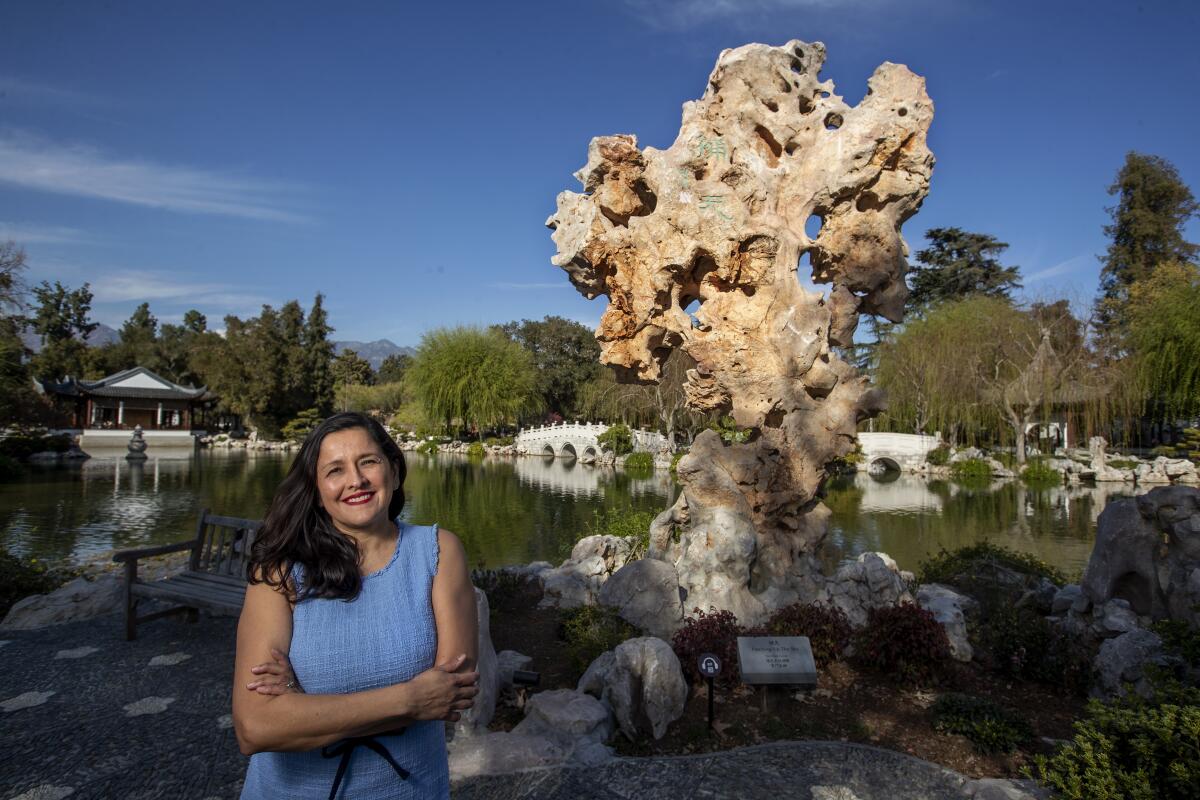
The strategic plan likewise calls for greater diversity in programming. That is something the institution has been chipping away at over the last half dozen years. In recent years there have been exhibitions and programs devoted to exploring Butler’s papers and the struggles she faced as a Black writer in an overwhelmingly white field, and the museum’s contribution to the last Pacific Standard Time, devoted to L.A. and Latin America, examined the Indigenous roots of some colonial art.
In addition, there have been numerous partnerships. In 2016 the museum launched an annual exhibition series called “/five,” in which it partnered with area cultural organizations to present exhibitions indoors and out. This has included collaborations with Clockshop and the Women’s Center for Creative Work, as well as the Vincent Price Art Museum — the latter resulting in a pair of fascinating installations by L.A. artists Mario Ybarra Jr. and Carolina Caycedo that examined art, labor and wealth. Caycedo’s beguiling 10-minute video installation featured Black, brown and queer dancers materializing like ghosts in the estate’s European-style spaces. The museum and VPAM ended up jointly acquiring the work.
And in 2019 the Huntington teamed with the Yale Center for British Art to bring a trio of contemporary art exhibitions curated by Pulitzer Prize-winning critic Hilton Als to the museum. The most recent in the series placed paintings of invented Black figures by London painter Lynette Yiadom-Boakye adjacent to the gallery containing the museum’s Grand Manner British portraiture. (The show was, unfortunately, cut short by the pandemic.)
More recently, the Huntington collaborated with UCLA’s Hammer Museum to showcase work from the Hammer’s “Made in L.A.” biennial, which features a diverse array of contemporary artists. Originally scheduled for 2020, that show is now set to make its appearance on April 17.
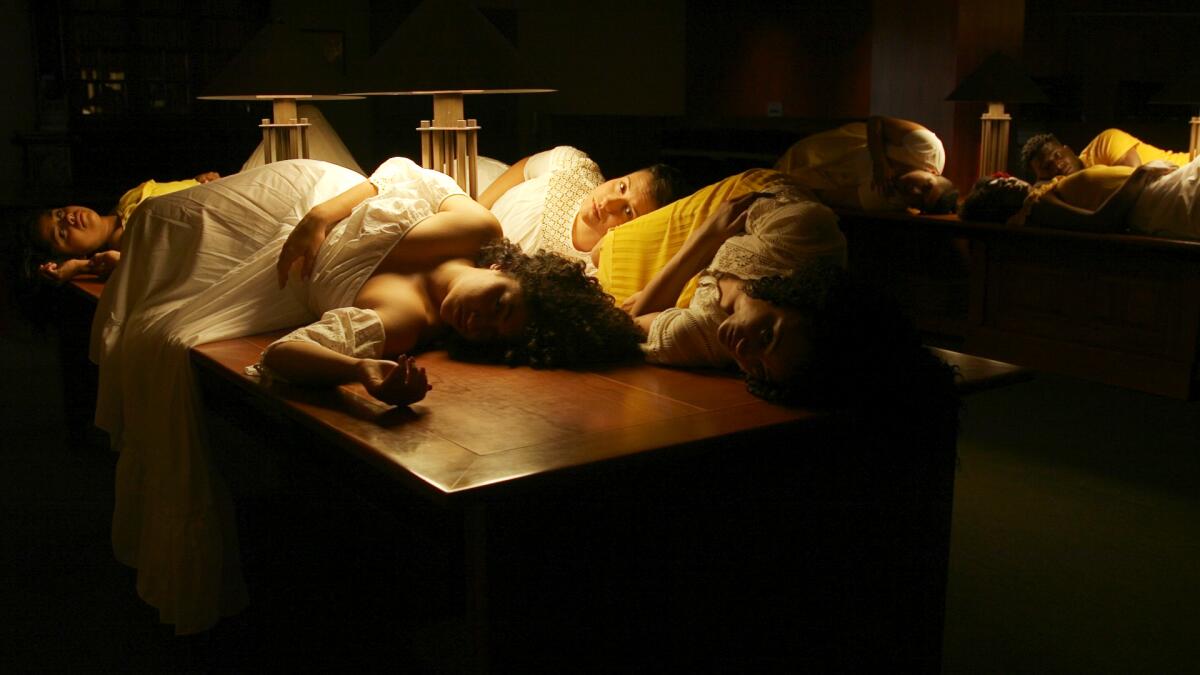
But shifting a narrative requires more than a few temporary exhibitions, and that is something Nielsen, who joined as director at the Huntington’s art museum 2 1/2 half years ago, says she is working on. “We have to diversify our staff,” she says. “We have to diversify our collection. We have to diversify the stories we tell.”
This has meant beginning to rethink the ways in which the collection is presented, along with the wall texts and other informational pieces that accompany it. “We are known for Grand Manner British portraiture from the 18th century,” she says. “If there was ever a group of people with inherited wealth or new wealth that came out of colonial endeavor — trade in rum and trade in sugar and trade in slaves. We are doing research to see which people in that gallery are connected to the slave trade. It’s about a third to a half. Will we make moves to acknowledge that? Absolutely.”
After “Made in L.A.” wraps in August, the galleries that hold those installations will be turned back over to the American art collections. This, says Nielsen, provides an opportunity to rethink that story as well.
To that end, the museum has enlisted L.A. painter Sandy Rodriguez, who is currently doing a combined residency at the Huntington and nearby CalTech. The new installation will be conceived not around a colonial narrative that begins with the arrival of English settlers on the East Coast. Instead, it will be framed around ideas of borderlands — and will connect the story of art in the galleries to the historic maps in the library’s archives to the native plants in the botanical gardens to the greater Southern California landscape.
“Sandy’s work is so much about place,” Nielsen says. “She is helping us connect the galleries inside with what is out there.”
In keeping with this, the Huntington has begun to come to terms with its own history — which is as storied as it is fraught.
The catalog for the museum’s centennial exhibition, “Nineteen Nineteen,” is quite frank about its founder’s legacy, citing Henry Huntington’s “hostility toward organized labor” and documenting the racial hierarchies that existed in his employ. A reproduction of a neatly inscribed ledger shows how fruit pickers with Anglo surnames earned about 50% more than those with Spanish ones.
Riffle through Sandy Rodriguez’s dense rack of painting supplies and you’ll turn up feathers, withered plants and a container of cochineal powder, the fiery red tint produced by the insect that feeds on the leaves of the prickly pear cactus.
The question now is whether some of these moves can lead to lasting institutional change.
In reporting this story, I interviewed a trio of former employees who greeted some of the new measures with skepticism. “There’s a certain noblesse oblige that goes on at these institutions,” says one ex-staffer, who asked to remain anonymous since the person still works in the field. “You do the right programs and you bring the right people and you look ‘woke,’ but nothing really changes.”
Lutz, however, says that her team is working on meaningful change.
“We talk a lot about ensuring that our DEI work, or any projects or changes we’re considering or proposing to the president and to senior staff, are genuine and substantive rather than performative.”
Wilson, co-curator of a groundbreaking new MoMA exhibition, counteracts architecture’s inherent racism with ideas framed by the Black experience.
“The biggest key asset, in order to fulfill our mission, is the people,” she adds. “And who takes care of the people? It’s another aspect of deferred maintenance. It will cost us more if we don’t invest. ... It’s like having a leaky pipe in the gallery. We have to invest and fix that.”
It is critical. What today might seem seem like a drip could one day become a flood.
The biggest entertainment stories
Get our big stories about Hollywood, film, television, music, arts, culture and more right in your inbox as soon as they publish.
You may occasionally receive promotional content from the Los Angeles Times.